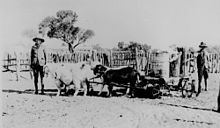 | ||
For sale park ridge south your address real estate 47 49 thylungra road
Thylungra Station is a pastoral lease that operates as a sheep station in Queensland.
Contents
- For sale park ridge south your address real estate 47 49 thylungra road
- Thylungra
- Description
- History
- References
Thylungra
Description
The property is situated approximately 101 kilometres (63 mi) north west of Quilpie and 108 kilometres (67 mi) south east of Windorah. Neighbouring properties include the Milo and Budgerygar aggregation and Arleun Station that are all owned or leased by George Scott, the current owner of Thylunga. It is situated in the Channel Country on Kyabra Creek, a tributary of Cooper Creek.
The property is predominantly open downs flood-out country with black soils to the south with large areas of gidyea stands interspersed wit low sandhills. The north is mostly mulga country with remainder of the property being stony range country.
The area is mostly Mitchell grass, Flinders grass, blue grass, bluebush, buttongrass, burr and neverfail on the floodplains. Timbered areas contain stands of gidyea, mulga, coolibah, yarpunyah, bloodwood and supplejack.
History
The traditional owners of the area are the Punthamara peoples, also known as the Buntamurra, who have inhabited the area for thousands of years.
The name Thylungra is taken from the Aboriginal word meaning permanent water, as one of the waterholes in the area was thought to be permanent.
The property was initially established as a cattle station by pioneer Patrick Durack in 1868 along with nearby Kyabra Station.
By 1878 the property had been placed on the market along with adjoining Bungindery Station. At this stage they occupied a combined area of 2,525 square miles (6,540 km2) and were stocked with 9,000 head of cattle and 300 horses.
In 1882 Durack left Thylungra to establish Argyle Downs Station in the Kimberley with approximately 7,250 head of cattle and 200 horses which he overlanded about 3,000 miles (4,828 km). Half the stock did not survive the journey which Durack completed nearly two and a half years later. Thylungra was sold some time in 1884 although Durack had legal action taken against him to recover the commission still owed to the company that sold the property. The purchasers were the Queensland Cooperative Pastoral Company who placed it on the market when it went into liquidation along with several other properties including Galway Downs, Buckingham Downs and Pikedale in 1886. At this time Thylungra occupied an area of 1,800 square miles (4,662 km2) and was stocked with 15,000 cattle and 200 horses. By 1890 the property was owned by the Thylungra Pastoral Company.
By 1896 the lessee was the Union Bank and the property was being managed by Henry Roche. The area was in its third year of drought in 1897 with very little feed on the ground. By 1902 the property was almost completely destocked.
At some time prior to 1906 the property had been stocked with sheep. In the same year the property was purchased by John Leahy, Robert Philip and James Forsyth. The property encompassed an area of about 1,000 square miles (2,590 km2) of country.
Shearers went on strike at Thylungra in 1910 demanding that better equipment be installed before they went back to work. The following year over 100,000 sheep were to be shorn at Thylungra. Leahy died some time before 1913 at which time the property was owned by Munro, Forsythe and Philip. Thylungra produced 107 bales of wool weighing over 18 long tons (18 t) the same year.
Thylungra was sold in 1992 by Toni Woods of Goondiwindi to Clyde Agricultural.
In 2008 the Clyde Agricultural Company sold Thylungra for A$10.5 million to George Scott in a private sale after it had been passed in at auction a month earlier. The property occupied an area of 2,820 square kilometres (1,089 sq mi) and was stocked with 45,000 sheep and almost 2,000 head of cattle.
